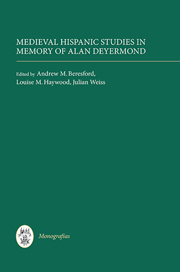Book contents
- Frontmatter
- Contents
- Contributors
- Foreword: Alan Deyermond: A Memoir
- Acknowledgments
- Abbreviations
- Introduction: Alan Deyermond, 1932–2009
- 1 Sanctity and Prejudice in Medieval Castilian Hagiography: The Legend of St Moses the Ethiopian
- 2 The Image of the Phoenix in Catalan and Castilian Poetry from Ausiàs March to Crespi de Valldaura
- 3 On the Frontiers of Juan Rodríguez del Padrón's Siervo libre de amor
- 4 Memory as Mester in the Libro de Alexandre and Libro de Apolonio
- 5 Advancing on ‘Álora’
- 6 Time is of the Essence: Essence, Existence, and Reminiscence in Two Portuguese Poets
- 7 Gómez Manrique's Exclamación e querella de la governación: Poem and Commentary
- 8 The Misa de amor in the Spanish Cancioneros and the Sentimental Romance
- 9 ‘Manus mee distillaverunt mirram’: The Essence of the Virgin and an Interpretation of Myrrh in the Vita Christi of Isabel de Villena
- 10 ‘Nos soli sumus christiani’: Conversos in the Texts of the Toledo Rebellion of 1449
- 11 Vernacular Commentaries and Glosses in Late Medieval Castile, II: A Checklist of Classical Texts in Translation
- 12 Games of Love and War in the Castilian Frontier Ballads: El romance del juego de ajedrez and El romance de la conquista de Antequera
- 13 ‘Esta tan triste partida’ (Conde Dirlos, v. 28a): maridos y padres ausentes
- Index
- Tabula in memoriam
2 - The Image of the Phoenix in Catalan and Castilian Poetry from Ausiàs March to Crespi de Valldaura
Published online by Cambridge University Press: 05 May 2013
- Frontmatter
- Contents
- Contributors
- Foreword: Alan Deyermond: A Memoir
- Acknowledgments
- Abbreviations
- Introduction: Alan Deyermond, 1932–2009
- 1 Sanctity and Prejudice in Medieval Castilian Hagiography: The Legend of St Moses the Ethiopian
- 2 The Image of the Phoenix in Catalan and Castilian Poetry from Ausiàs March to Crespi de Valldaura
- 3 On the Frontiers of Juan Rodríguez del Padrón's Siervo libre de amor
- 4 Memory as Mester in the Libro de Alexandre and Libro de Apolonio
- 5 Advancing on ‘Álora’
- 6 Time is of the Essence: Essence, Existence, and Reminiscence in Two Portuguese Poets
- 7 Gómez Manrique's Exclamación e querella de la governación: Poem and Commentary
- 8 The Misa de amor in the Spanish Cancioneros and the Sentimental Romance
- 9 ‘Manus mee distillaverunt mirram’: The Essence of the Virgin and an Interpretation of Myrrh in the Vita Christi of Isabel de Villena
- 10 ‘Nos soli sumus christiani’: Conversos in the Texts of the Toledo Rebellion of 1449
- 11 Vernacular Commentaries and Glosses in Late Medieval Castile, II: A Checklist of Classical Texts in Translation
- 12 Games of Love and War in the Castilian Frontier Ballads: El romance del juego de ajedrez and El romance de la conquista de Antequera
- 13 ‘Esta tan triste partida’ (Conde Dirlos, v. 28a): maridos y padres ausentes
- Index
- Tabula in memoriam
Summary
Alan Deyermond discussed the phoenix in two important articles: one in Galician (2002), concerning four bestiary birds in Spanish medieval literature; and the other, in Castilian, on bestiary images in the Catalan poetry of Roís de Corella (2007: 119–31). My purpose is to expand upon this research within the confines of fifteenth-century Castilian and Catalan poetry. exploring the spectrum of symbolic meanings that the phoenix had, beginning with poems addressed to Lucrezia d'Alagno at the Neapolitan court of Alfonso the Magnanimous, surveying the Petrarchan image of the phoenix in Castilian poetry from Santillana to Boscán, examining this symbol in more detail in the love poetry of Juan de Mena and Roís de Corella, and ending with the way in which this image was applied to Queen Isabel by Pedro Marcuello, Gerónimo Pinar, and Crespí de Valldaura.
In Jungian terms, the phoenix is a universal cultural archetype, found in China, India and the Arab world as well as in Western Europe (Zambon and Grossato 2004). Even in European literature and art, this myth has a multiplicity of variants (Mermier 1989). In most accounts, this beautiful bird is associated with India, or ancient Egypt, and its nest, made of spice twigs or palm fronds, is ignited by the sun's rays; the bird fans the flames with its wings and is quickly consumed, and a new phoenix is born from the ashes, in a cycle that is repeated every five hundred years or more.
- Type
- Chapter
- Information
- Medieval Hispanic Studies in Memory of Alan Deyermond , pp. 39 - 70Publisher: Boydell & BrewerPrint publication year: 2013



